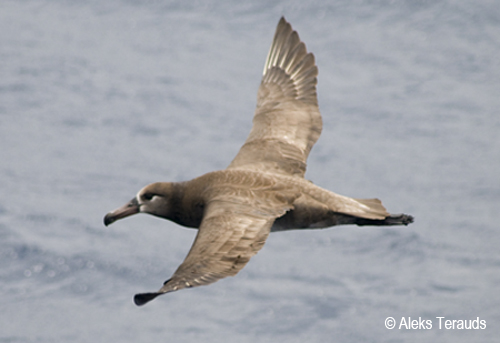P.E. Michael (Hawai'i Pacific University, Marine Science Program at Oceanic Institute, Waimanalo, Hawaii, USA) and colleagues, writing in the journal Fisheries Oceanography, report on the at-sea distribution of Black-footed Albatrosses Phoebastria nigripes in relation to oceanographic features off California, USA.
The paper’s abstract follows:
“Effective conservation of highly mobile species requires an understanding of the factors that influence their habitat use patterns, locally and within a large-scale oceanographic context. We characterized the seasonal (chick-rearing, post-breeding) and inter-annual (2004–2008) distribution and abundance of black-footed albatross (Phoebastria nigripes; BFAL) along the central California continental shelf/slope using standardized vessel-based surveys. We used a hypothesis-based information-theoretic approach to quantify the relative influence of environmental conditions on BFAL occurrence and abundance by assessing their association with: (i) local static bathymetric features, (ii) local and regional dynamic oceanographic processes, and (iii) seasonal and inter-annual basin-wide variability. While the presence/absence models yielded stronger results than the abundance models, both revealed that static and dynamic features influence BFAL habitat use. Specifically, occurrence was greatest near the shelf-break, particularly in months with strong upwelling. High BFAL densities were associated with Rittenburg Bank, especially during the chick-rearing season, periods of positive North Pacific Gyre Oscillation index and large northern monthly upwelling, evidenced by cool, salty waters in the study area. BFAL aggregation intensity was greatest onshore of the shelf-break (200 m isobath). Behavioral observations reinforced the notion that transiting BFAL are widely dispersed near the shelf-break and concentrate in large flocks of birds sitting on the water farther onshore. These results underscore the need to consider oceanographic processes at multiple spatial scales when interpreting changes in BFAL dispersion within marine sanctuaries, and highlight the feasibility of implementing bathymetrically defined protected areas targeting predictable BFAL aggregations within these larger management jurisdictions.”

Black-footed Albatross at at sea. Photograph by Aleks Terauds
Reference:
Michael, P.E., Jahncke, J. & Hyrenbach, K.D. 2013. Relative influence of static and dynamic features on black-footed albatross (Phoebastria nigripes) habitat use in central California Sanctuaries. Fisheries Oceanography DOI: 10.1111/fog.12039.
John Cooper, ACAP Information Officer, 23 July 2013

 English
English  Français
Français  Español
Español